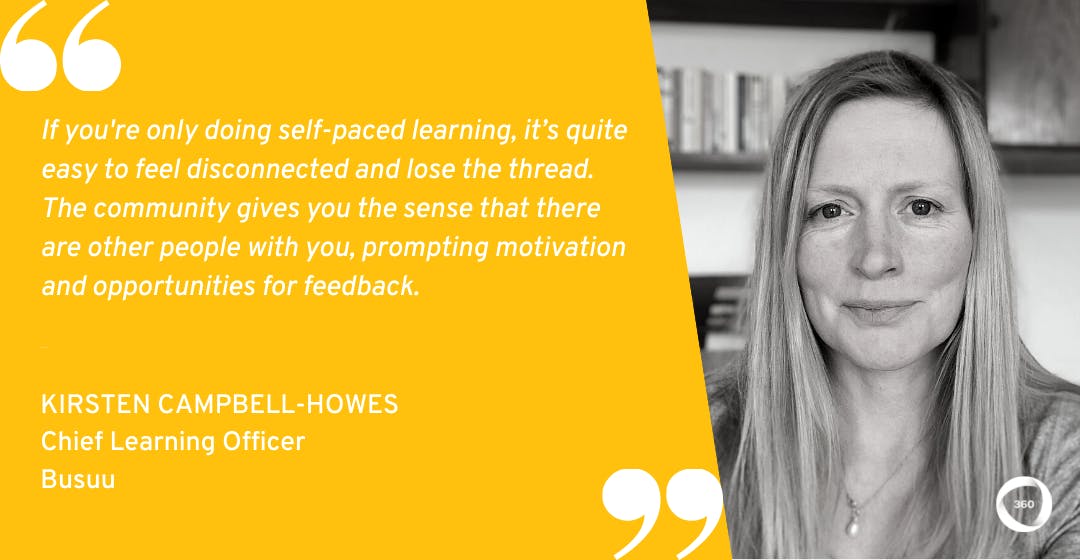L&D teams often lean towards creating self-paced learning programs—and rightly so. This type of learning gives employees the freedom to learn when it suits them and drives their ownership of their learning.
But when it comes to learning a new language, self-paced learning isn’t enough on its own—to become fully fluent in a language you need social interaction.
So, how can you combine the convenience of self-paced study with the power of social interaction to create an impactful language learning program for your employees? And how can you ensure that the self-paced components of your program don't leave learners feeling disconnected from their peers and community?
Fortunately, Kirsten Campbell-Howes, Chief Learning Officer at Busuu has the answers, plus a 3-step playbook to boot. In my latest expert interview, Kirsten shares her approach to embedding community in self-paced language learning, and how she and her team ensure they make impact on learners’ fluency.
Read to hear why embedding community in self-paced learning is so important for an online language learning platform like Busuu.
Loving what you’re reading? Come and join the L&D Collective for more great learning insights, resources, and events!
The power of embedding community in self-paced learning
Busuu has been around for 14 years and is one of the biggest global online language learning companies.
“What's special about Busuu is the way we embed community in our learning. We are a global community of more than 120 million people, learning 13 different languages from one another—everyone who is a student on Busuu is also a teacher.”
As Kirsten explains, the community work is threaded through our self-paced language courses, allowing learners unlimited opportunities to practice speaking and writing, through which Busuu is able to accelerate people’s fluency.
What's special about Busuu is the way we embed community in our learning. We are a global community of more than 120 million people, learning 13 different languages from one another—everyone who is a student on Busuu is also a teacher.
“I've been at Busuu for seven years, and my main role is to look after our learning design team who create our courses, and our teacher operations team who support our global team of teachers delivering our live lessons.”
But what is Kirsten’s approach for creating impactful social learning through community? Read on to hear about her three-step playbook.
Looking for more expert insights? Find out how L&D leaders at Amazon, WhatsApp, Klaviyo and more are driving growth with the right L&D strategy.

You have questions–the experts have the answers
By providing your contact info, you agree to receive communications from 360Learning. You can opt-out at any time. For details, refer to our Privacy Policy.
Busuu’s 3-step playbook to embedding community in self-paced learning
Kirsten and her team have found that people who engage the most with the Busuu community improve their fluency dramatically.
So, what is Kirsten’s first step toward helping learners engage with the Busuu community? First, she says it is all about creating the space for learners to get feedback from others.
1. Teach and learn from one another
There are many people on Busuu who are very enthusiastic about engaging with the community and who get a lot of value from getting feedback on their speaking and writing.
“If you look at a learner's history of submitting speaking and writing exercises, even in the course of a few weeks, you can see improvements in fluency. You can see and hear utterances becoming more complex, grammar becoming more developed, sentence length increasing, and so on,” she explains.
Kirsten and the team also found that those who are correcting others get a sense of self-efficacy, remembering that they are a master in a language they speak which makes them feel better about mistakes made in their new language.
“So, there's a lot going on, but it's a valuable experience on multiple dimensions for people to teach and learn from one another,” says Kirsten.
Next up, Kirsten and the team focused on creating a virtuous circle between self-paced, community, and live learning.
Related: Udacity’s 4 Steps for Creating Memorable Learning Experiences with Subject-Matter Experts
2. Interlink learning environments to ramp up mastery and motivation
For Kirsten, the optimal learning environment includes three elements: self-paced study, community, and live lessons interlinked in a virtuous circle.
“If you're only doing self-paced learning, it’s quite easy to feel disconnected and lose the thread. The community gives you the sense that there are other people with you, prompting motivation and opportunities for feedback.”
Kirsten and her team have constructed the curriculum with live lessons scheduled throughout the course, with community study as the training wheels for having real conversations. In live lessons, learners are either having one-to-one classes or engaging with peers in small group classes.

“This approach allows learners to take everything they’ve learned in the self-paced courses and practiced asynchronously in the community and apply it in the live lessons—learners can have real synchronous conversations and hear themselves spontaneously using the language that you've learned. And that's very motivational.”
“It can be quite intimidating, and so we try to encourage people not to overexert themselves into too many live lessons in a given week. But taken together, all of these study formats layered over one another help build rapid spoken fluency and a sense of confidence, says Kirsten.”
The final step to embedding community in self-paced learning? Adopting a collaborative spirit.
Related: How Harry’s Decentralize L&D with Self-Directed and Collaborative Learning
3. Motivate and activate the collaborative spirit
In Kirsten’s experience, the most successful social learning programs are those where the L&D team is involved in actively encouraging, motivating, and incentivizing teams to take part.
“Access to an app like Busuu is a great perk for your employees. And a portion of your employees will seize on that opportunity and consume everything.”
“But when team leaders get involved to help coalesce groups of people together, create leaderboards, or provide incentives for people to progress, that creates another level of community that can activate a collaborative spirit within a team, says Kirsten”
Kirsten has repeatedly seen L&D managers involved in encouraging people to take part in language programs, resulting in great success and off the chart engagement levels.
But when team leaders get involved to help coalesce groups of people together, create leaderboards, or provide incentives for people to progress, that creates another level of community that can activate a collaborative spirit within a team.
“Language programs can work if you have a super motivated group of people with really strong reasons for learning a language. But in other circumstances, the more involved L&D teams get, the more output you get from learners.”
Busuu’s approach to embedding community in self-paced learning highlights the advantages of collaborative learning. By creating a community of learners who are engaging with each other, Kirsten and her team are helping people to stay motivated and increase their new language fluency.
Finally, how does Kirsten measure the impact on fluency and engagement?
Related: 3 Data-Based Ways To Prove Training ROI (+ Free Training ROI Calculator)
Measuring the impact of Busuu’s community-led social learning
When measuring the impact of their community learning, Kirsten and the team monitor three metrics.
“The number of hours spent on the platform is a good measure of impact, but only if the course is designed well, and those hours are well spent. Putting in those hours will improve your fluency. But on its own, that measure is not sufficient at all.”
“So, we design our courses to be benchmarked to the CFR which is this global standard of progress in language learning. All our lessons are mapped to can-do statements and then we have certificates at the end of our levels that correspond to the CFR guidance.”
As Kirsten explains, there is also a qualitative measure of how confident the learner feels when speaking. If the course is designed correctly, after a couple of hours of learning a learner should feel that they are able to say more and feel more confident.
“Yes, that's subjective, but it's very important because if the learner doesn’t feel confident in their ability then the chances are their time has been wasted, or the course is not right in some way.”
“So, I would say this mixture of hours spent, progress towards certification, and the subjective measure of how the learner feels about their capabilities now compared to the beginning are the gold standard of measurement.”
Thanks to Kirsten for sharing her community-led learning experience and insights with us!
For more advice about connecting learners through community building, check out our interviews with Maitri Malia of Johnson Controls on creating a peer learning strategy for digital transformation, and Johnathan Saller of Disney Media & Entertainment Distribution on building a mentor circle program.
Want more peer insights on transforming workplace learning? Sign up to become a member of the L&D Collective, and check out our other #CLOConnect interviews with top L&D leaders on driving growth and scaling culture through Collaborative Learning. Or you can subscribe (below 👇) to our weekly newsletter to receive our latest posts directly in your inbox.


